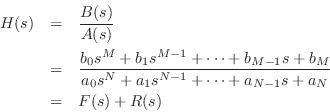Method
As can be seen from the code listing, this implementation of
residuez simply calls residue, which was written to
carry out the partial fraction expansions of ![]() -plane
(continuous-time) transfer functions
-plane
(continuous-time) transfer functions ![]() :
:

where ![]() is the ``quotient'' and
is the ``quotient'' and ![]() is the ``remainder'' in the PFE:
is the ``remainder'' in the PFE:
where
In the discrete-time case, we have the ![]() -plane transfer function
-plane transfer function
For compatibility with Matlab's residuez, we need a PFE of the form

where ![]() .
.
We see that the ![]() -plane case formally does what we desire if we
treat
-plane case formally does what we desire if we
treat ![]() -plane polynomials as polynomials in
-plane polynomials as polynomials in ![]() instead of
instead of
![]() . From Eq.
. From Eq.![]() (J.2), we see that this requires reversing the
coefficient-order of B and A in the call to
residue. In the returned result, we obtain terms such as
(J.2), we see that this requires reversing the
coefficient-order of B and A in the call to
residue. In the returned result, we obtain terms such as

Next Section:
Example with Repeated Poles
Previous Section:
The Padé-Prony Method





















